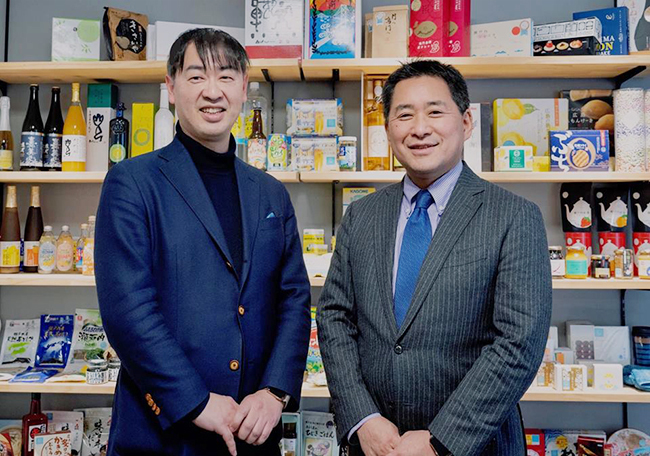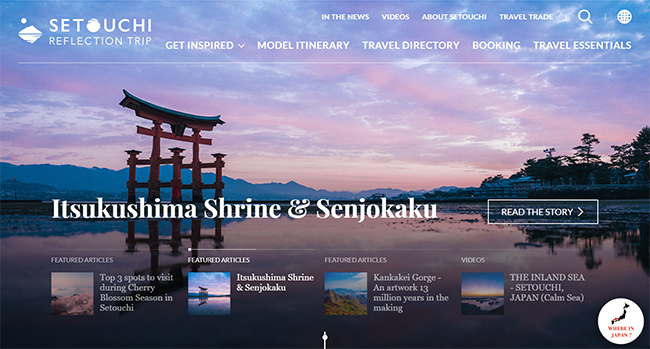In regional tourism initiatives, examples are emerging where municipalities collaborate beyond their boundaries to build brands. A prime example is "Setouchi DMO." We spoke with Akihisa Fujita, President of the Setouchi Brand Corporation, one of its constituent organizations.
About Setouchi DMO:
An organization promoting sustainable tourism development by creating demand and strengthening supply systems for tourism products and services across the seven prefectures surrounding the Seto Inland Sea (Hyogo, Okayama, Hiroshima, Yamaguchi, Tokushima, Kagawa, Ehime). It comprises entities including the General Incorporated Association Setouchi Tourism Promotion Organization and Setouchi Brand Corporation. It is one of the first wide-area DMOs (*) certified by the Japan Tourism Agency.
※DMO = Destination Management/Marketing Organization. An organization that acts as a coordinator for tourism regional development, managing municipalities, businesses, residents, and others in an integrated manner to revitalize the area.
Maximizing the Setouchi region's potential by transcending municipal boundaries
Konishi: The Setouchi DMO is a very unique organization, responsible for regional branding across a wide area, transcending the framework of individual municipalities. What is its background and what are its characteristics?
Fujita: In 2013, the "Setouchi Brand Promotion Alliance" was formed across the seven Setouchi prefectures. The Setouchi DMO emerged as an evolved form of this alliance. It's an initiative to enhance regional value not just through individual prefectures, but through collaboration among all seven. A key feature is that the DMO itself holds a fund and provides financial support to tourism businesses.
It would be a shame if tourists visiting the Setouchi region only enjoyed one prefecture. We collaborate across prefectural borders to guide visitors to "the attractive place right next door." By transcending the "municipal boundaries" that don't exist for tourists, we unlock the potential of the entire region.
Konishi: Starting in 2019, major news outlets in Europe and America began featuring "SETOUCHI" as a global destination one after another.
Fujita: Being ranked highly as a "must-visit area in 2019" by publications like The New York Times is a significant achievement. While "SETOUCHI" wasn't widely known overseas before, it's now frequently searched.
However, while establishing the SETOUCHI brand, we are always mindful of the distinction from the tourism initiatives undertaken by each prefecture. Our primary role is to enhance the tourism value of the entire Seto Inland Sea area and maximize both the intention to visit and the satisfaction of visitors.

From left: Keisuke Konishi of Dentsu Inc., Akihisa Fujita, President of Setouchi Brand Corporation
Preserving Seto Inland Sea's industries and culture through tourism
Konishi: Initiatives like those in Ise-Shima or the Snow Country tourism region, where broader areas spanning administrative boundaries are viewed and managed as brands from the customer (tourist) perspective, are increasing nationwide. On the other hand, I imagine there are challenges in unifying the efforts of individual municipalities and businesses under a large brand like "Setouchi." How do you establish and share common values and meaning?
Fujita: Large corporations create corporate brands by uniting various product brands, right? The vast Setouchi area is the same. I believe the Setouchi brand emerges by gathering the diverse brilliance shown by each region's tourism resources, culture, and history through several distinct approaches, connecting them with other approaches, and leveraging their synergistic effects.
Setouchi DMO currently targets "visitors from Europe, the US, and Australia." They've also established six themes (cruises, cycling, art, food, lodging, local products) as distinctive approaches to the Setouchi experience.
Konishi: Themes like cruises, cycling, and art are precisely the elements that enhance the unique natural and cultural appeal of the Seto Inland Sea. They seem like themes that would also attract Western visitors for extended stays.
Fujita: The appeal of cruises and cycling truly grows when viewed across the entire region. The launch of the overnight cruise ship "Gantzū" for touring the Seto Inland Sea, followed by the development of cycle ships capable of carrying 50 bicycles and 50 cyclists simultaneously, has heightened momentum for introducing new vessels across various routes. The development of cycling infrastructure, which began with the Shimanami Kaido, has now spread throughout the entire Seto Inland Sea area.
Moreover, the Seto Inland Sea has long flourished as a major artery of maritime traffic, and its historical sites remain today. Foreign tourists have a strong desire to deeply understand the local culture. Therefore, we emphasize that tourist information centers and guides should not only be multilingual but also respect diverse global cultures while conveying the cultural value of the Seto Inland Sea.

The
SETOUCHI TRIP website, established by the Setouchi DMO for inbound tourists, supports six languages.
Konishi: Many of the Setouchi region's tourist attractions are located along the coast. Indeed, relying solely on rail travel makes access time-consuming and tends to fragment sightseeing into isolated "points." Direct sea routes would significantly boost demand for travel-stay tourism. Another key factor is the region's unique food culture, which is vital for enhancing destination value and repeat visitation.
Fujita: Regarding local products and food, we've established the Setouchi Brand Registration System. By having products carry this mark, we aim to work with businesses to raise awareness of the richness of our food culture and enhance the brand. We also operate the e-commerce site "Living with the Islands," which sells Setouchi specialties while introducing the wisdom of those involved in agriculture and fisheries. We believe that having people taste the products while learning about the hardships, joys, and background of their creation contributes to enhancing the brand as a gourmet area.
Furthermore, by sparking interest in the region's food culture through e-commerce sales, we attract tourism seeking fresher ingredients and rare local products. Ultimately, we aim to increase the working population and permanent residents. We want to protect the Seto Inland Sea's industries and culture, starting with tourism.
Initiatives also emerge from citizens, fostering civic pride.
Konishi: A key point for Setouchi DMO is actively working to build a community that unites residents and businesses—the main actors—as a platform to enhance brand value.
Fujita: Another goal is for tourism to foster civic pride—residents' pride and attachment to their region. We want locals to recognize that things they took for granted have value worthy of global visitors. As a result, Setouchi's municipalities, private businesses, and citizens will simultaneously and spontaneously implement tourism initiatives. We envision tourism communities emerging and becoming self-sustaining across Setouchi, transforming it into a world-class tourism destination.
Specifically, we have established mechanisms involving businesses, municipalities, and residents, such as the "Setouchi DMO Members" organization, which promotes awareness and knowledge about tourism and supports the growth of tourism businesses, and the "Setouchi Holics" network for residents interested in tourism.
Konishi: President Fujita, you moved to the Setouchi region yourself, having no prior local ties, to take on this work. What kind of success vision or goals do you have?
Fujita: A regional brand is formed by the accumulation of individual entities. It involves communicating the "light" rooted in the region using contemporary expression methods, allowing people to "see," feel, learn, and achieve deep satisfaction. It is only through this cycle, where each communication becomes refined, and we can provide world-class satisfaction, that we can finally say the "Setouchi" regional brand has taken root. Precisely because this is work that may take 10 years, or even 100 years, it is something that local governments, businesses, and residents must build together, pooling their efforts.
(After the Dialogue)
Achieving successful global regional branding across a wide area, creating tangible value through business support and community building
The SETOUCHI brand, attracting global media attention. The Setouchi DMO, comprising three organizations, shares a common regional theme. It advances initiatives with unified centripetal force, encompassing not only tourist promotions but also investment through funds, management/product development support for businesses, and membership programs fostering cross-regional co-creation communities.
This regional branding initiative, involving professional talent and employing a global mindset that extends to business development support, stands as an advanced case study for all of Japan. It will help manifest the diverse values of Japan in this new era.









